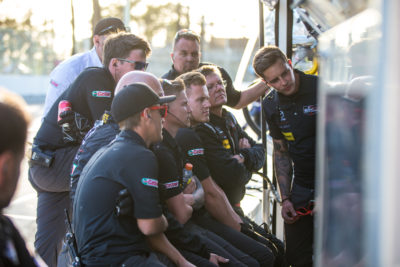Not everyone has access to the best in the business when it comes to improving their race car, especially on a Club Racing budget.
What we all have, however, is access to Mazda as part of the Mazda Motorsports family. And with that Mazda access comes some of the best in the specialty business, such as Multimatic Motorsports.
Multimatic serves as a technical partner for Mazda Team Joest (Mazda’s Prototype racing team in IMSA – the International Motor Sports Association), providing technical support before, during, and after the race at the highest level of sports car racing. This includes monitoring data and telemetry, before, during, and after on-track sessions.
While your Club Racing setup may not be this intense, the process for the Mazda RT24-P is both a fascinating insight into how telemetry is captured and may provide some tips for you at home.
With the Prototype team, Multimatic monitors both the car and driver. Engine temperatures and pressures, gearbox temperatures and pressures, brake temperatures, tire temperatures, fuel loads – almost anything you can think of on the car shows up live in pit lane through a network carried over cellular data.
In addition, the speed of the car, throttle, brakes, gear and steering input travel back to pit lane as well.
That real time data collection is the head start those in the pits need to prepare for setup changes, without waiting for the session’s checkered flag.
That’s an important distinction, especially in the IMSA WeatherTech SportsCar Championship, where fractions of a second matter. But when it boils down to it, the hard part isn’t necessarily collecting the data – it’s interpreting them.
That’s where the Multimatic crew, working with Mazda Team Joest, really earn its worldwide reputation as the best in the business. That team includes Vehicle Dynamics Engineer Vice Libertucci, who sits trackside during every Mazda Team Joest session in 2018.
Those responsibilities, of course, cover both the car and the driver performance.
“You can watch a driver as he’s driving the lap,” Libertucci said. “You can see the lap with him. If you’ve made a change to the car, you can overlay the day’s previous best lap and see how he’s steering differently, how he’s braking differently. It gives you a heads up on what he’s experiencing before he even gets back.”
But with professional drivers behind the wheel at Mazda Team Joest, influences on the driver may well be predicated by changes in the car.
“We can see how setups are changing the chassis performance of the car,” Libertucci said. “Downforce going up or down, balance changing on the car. You can see if the car gets damaged, how that damage is affecting the performance. If the car gets dinged up during the race, you can see if you need to come in and change some bodywork.
“You can see exactly what the driver is experiencing, while he’s experiencing it. If he has an oversteer moment in the entry of a corner, you can see a steering correction. You can immediately know he’s struggling a bit more on exits, perhaps. The other thing you can watch is the brake locking, to see where he’s locking, if he’s locking fronts or rears and see if the brake bias is off.
All of that allows engineers to think about set-up changes in advance, instead of waiting until the post-race debrief to speak to drivers.
“It does give you an idea of what he’s going through, as he’s doing it. You can preempt some things before he comes back and gives you the full debrief.”
Despite the wild amount of information and human resources, there are a number of similarities to the Club Racing game.
“A really simple thing we watch is the predictive lap time,” Libertucci said. “You can use that as the driver uses that, to see how certain setups are gaining or losing in certain segments.”
And just like in Club Racing, the amount of data can seem overwhelming at first. The important thing to remember is that none of it matters without context.
“Knowing the correct ranges of things so that you can set up your gates and how you set your colors, so that you know at a glance when something isn’t right,” Libertucci says of the process that works for him. “You should spend a little bit of time ahead knowing and thinking about what you expect to see. When there’s something you’re not expecting, it stands out a little bit more.”
If you’ve got the ability, the way you organize that data can help out.
“When I’m viewing the data, I like to use color a lot,” Libertucci said. “When things are wrong, I make them red, and when they’re okay I make them green. That way, at a glance, you can see if something isn’t in the right window.
“I like to save an overlay of (a lap) that I know is good, maybe a previous best lap. I keep an overlay of that on the telemetry, so it stands out more when you’re deviating from that.”
That “good” data can come from your best lap or, if you just don’t have the speed yet, from another, faster driver who has taken a lap in your car.
In our next article, we’ll turn to some of Mazda’s drivers to see how they handle data to become better racers, and how that compares to our new understanding of what an engineer looks for. Stay tuned, here at MazdaMotorsports.com!


 ACCESSIBILITY
ACCESSIBILITY